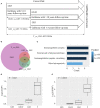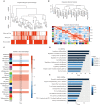RNA Sequencing Revealed Signals of Evolution From Gallbladder Stone to Gallbladder Carcinoma
- PMID: 32547950
- PMCID: PMC7272658
- DOI: 10.3389/fonc.2020.00823
RNA Sequencing Revealed Signals of Evolution From Gallbladder Stone to Gallbladder Carcinoma
Abstract
Gallbladder stone is a major risk factor for gallbladder carcinoma (GBC), while there is still a controversy whether period of follow-up since newly diagnoses of asymptomatic gallstones increases the risk of GBC. In this study, 10 GBC patients and 30 patients with gallstones were admitted to our hospital. Patients with gallstones were divided into 3 groups according to the follow-up time, involving 10 patients with follow-up period of 1-3 years (GS3 group), 10 patients with follow-up period of 5-10 years (GS5 group), and 10 patients with follow-up period of more than 10 years (GS10 group). Tumor and para-tumor tissues of GBC patients, and gallbladder tissues of gallstone patients were collected. RNA sequencing was performed on the 50 samples. Besides, 1,704 differentially expressed genes (DEGs) were identified in tumors compared with para-tumor tissues of 10 GBC patients, which were enriched into some well-known cancer-related pathways, such as PI3K-Akt, mitogen-activated protein kinase (MAPK), Ras, and Wnt signaling pathways, and the most significant pathway was neuroactive ligand-receptor interaction. Patients with gallstones with periods of follow-up equal to 1-3 and > 10 years showed to have higher cancer risk than those with 5-10 years. ALPP and GPR87 are potential biomarkers for predicting cancer risk in patients with gallstones. The in vitro results revealed that GPR-87 can promote the proliferation, migration, and invasion of GBC cells. Herein, we explored the relationship between GBC patients and patients with gallstones with different periods of follow-up in transcriptome level.
Keywords: ALPP; GPR87; RNA sequencing; follow-up time; gallbladder carcinoma; gallbladder stone.
Copyright © 2020 Wang, Xu, Cheng, Zhao, Wu, Li, Ma, Liu and Jiang.
Figures







References
LinkOut - more resources
Full Text Sources

